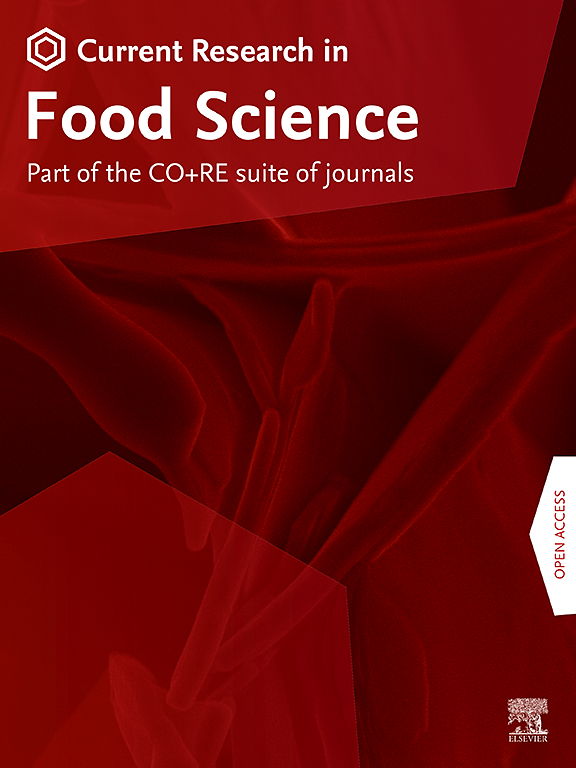Optimization of the germination time of proso and foxtail millets to enhance the bioactive properties, antioxidant activity, and enzymatic power and reduce antinutritional factor
IF 6.2
2区 农林科学
Q1 FOOD SCIENCE & TECHNOLOGY
引用次数: 0
Abstract
The germination of millets is a traditional yet underutilized method to enhance their nutritional and functional attributes. This study investigates the impact of germination time on the bioactive, enzymatic, and antinutritional properties of proso millet (Chino Dude) and foxtail millet (Kaguno Red and Kaguno White) varieties. Germination was conducted over five days (0–5 days), and changes in total phenolic and flavonoid content, tannin content, antioxidant activity, diastatic power, α-amylase activity, reducing sugars, and trypsin inhibition activity were measured. A two-way ANOVA revealed significant effects (p < 0.05) of varietal differences and germination time on these properties. Total phenolic and flavonoid content and antioxidant activity increased significantly (p < 0.05) unit day 3 of germination after which it decreased until day 5. Tannin content and trypsin inhibitor decreased significantly (p < 0.05) from day 1 to day 5 of germination, whereas diastatic power and α-amylase increased (p < 0.05) with an increase in germination time. The optimal germination time was determined to be 3.46 days using multiple regression models to maximize bioactive compounds and enzymatic activity while minimizing antinutritional factors. Moreover, Kaguno Red exhibited the highest bioactive levels, while Kaguno White had the lowest trypsin inhibition activity, indicating varietal-specific differences in analyzed parameters. This study highlights the potential of tailored germination strategies to enhance the nutritional and functional profiles of millets, providing actionable insights for functional food development in regions reliant on millet as a staple crop.

优化芽谷子和谷子的萌发时间,提高其生物活性、抗氧化活性和酶促力,降低抗营养因子
小米的发芽是一种传统的但尚未充分利用的方法,以提高其营养和功能属性。本研究研究了萌发时间对黑麦和黑麦(黑麦红和黑麦白)的生物活性、酶和抗营养特性的影响。萌发5 d (0 ~ 5 d),测定其总酚和类黄酮含量、单宁含量、抗氧化活性、消散力、α-淀粉酶活性、还原糖和胰蛋白酶抑制活性的变化。双向方差分析显示显著影响(p <;0.05),品种差异和萌发时间对这些特性的影响。总酚和类黄酮含量及抗氧化活性显著提高(p <;0.05),之后开始下降,直到第5天。单宁含量和胰蛋白酶抑制剂显著降低(p <;0.05),而发芽率和α-淀粉酶均升高(p <;0.05),随萌发时间的增加而增加。采用多元回归模型,以最大限度地提高其生物活性成分和酶活性,同时最大限度地降低其抗营养因子,确定其最佳发芽时间为3.46 d。此外,香野红表现出最高的生物活性水平,而香野白则表现出最低的胰蛋白酶抑制活性,表明所分析参数的品种特异性差异。该研究强调了定制发芽策略的潜力,以增强小米的营养和功能概况,为依赖小米作为主要作物的地区的功能食品开发提供可操作的见解。
本文章由计算机程序翻译,如有差异,请以英文原文为准。
求助全文
约1分钟内获得全文
求助全文
来源期刊

Current Research in Food Science
Agricultural and Biological Sciences-Food Science
CiteScore
7.40
自引率
3.20%
发文量
232
审稿时长
84 days
期刊介绍:
Current Research in Food Science is an international peer-reviewed journal dedicated to advancing the breadth of knowledge in the field of food science. It serves as a platform for publishing original research articles and short communications that encompass a wide array of topics, including food chemistry, physics, microbiology, nutrition, nutraceuticals, process and package engineering, materials science, food sustainability, and food security. By covering these diverse areas, the journal aims to provide a comprehensive source of the latest scientific findings and technological advancements that are shaping the future of the food industry. The journal's scope is designed to address the multidisciplinary nature of food science, reflecting its commitment to promoting innovation and ensuring the safety and quality of the food supply.
 求助内容:
求助内容: 应助结果提醒方式:
应助结果提醒方式:


